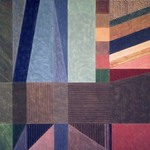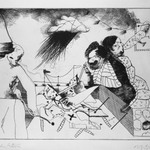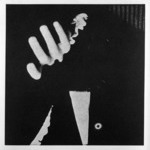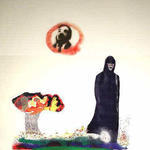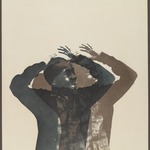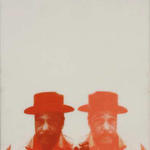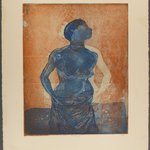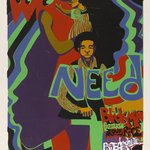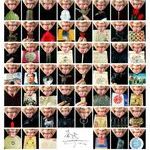
Morning After
Dindga McCannon
Contemporary Art
MEDIUM
Color linocut with oil-based ink
DATES
1973
DIMENSIONS
block: 13 1/2 × 19 1/2 in. (34.3 × 49.5 cm)
frame: 22 7/8 × 28 7/8 × 1 3/4 in. (58.1 × 73.3 × 4.4 cm)
sheet: 16 1/2 × 24 in. (41.9 × 61 cm) (show scale)



SIGNATURE
Signed in pencil
INSCRIPTIONS
Dated and titled in pencil
COLLECTIONS
Contemporary Art
ACCESSION NUMBER
2012.80.30
CREDIT LINE
Gift of R.M. Atwater, Anna Wolfrom Dove, Alice Fiebiger, Joseph Fiebiger, Belle Campbell Harriss, and Emma L. Hyde, by exchange, Designated Purchase Fund, Mary Smith Dorward Fund, Dick S. Ramsay Fund, and Carll H. de Silver Fund
PROVENANCE
By 2012, purchased from the artist by David Lusenhop of Hamtramck, MI and M. M. Azzi Fine Art & Design, Inc., Chicago, IL; 2012; purchased by the Brooklyn Museum.
Provenance FAQ
EXHIBITIONS
MUSEUM LOCATION
This item is not on view
CAPTION
Dindga McCannon (American, born 1947). Morning After, 1973. Color linocut with oil-based ink, block: 13 1/2 × 19 1/2 in. (34.3 × 49.5 cm). Brooklyn Museum, Gift of R.M. Atwater, Anna Wolfrom Dove, Alice Fiebiger, Joseph Fiebiger, Belle Campbell Harriss, and Emma L. Hyde, by exchange, Designated Purchase Fund, Mary Smith Dorward Fund, Dick S. Ramsay Fund, and Carll H. de Silver Fund, 2012.80.30. © artist or artist's estate (Photo: Brooklyn Museum, 2012.80.30_PS20.jpg)
EDITION
Edition of 50, printed by the artist
IMAGE
detail, 2012.80.30_PS20.jpg. Brooklyn Museum photograph, 2023
"CUR" at the beginning of an image file name means that the image was created by a curatorial staff member. These study images may be digital point-and-shoot photographs, when we don\'t yet have high-quality studio photography, or they may be scans of older negatives, slides, or photographic prints, providing historical documentation of the object.
RIGHTS STATEMENT
© Dindga McCannon
The Brooklyn Museum holds a non-exclusive license to reproduce images of this work of art from the rights holder named here.
The Museum does not warrant that the use of this work will not infringe on the rights of third parties. It is your responsibility to determine and satisfy copyright or other use restrictions before copying, transmitting, or making other use of protected items beyond that allowed by "fair use," as such term is understood under the United States Copyright Act.
For further information about copyright, we recommend resources at the United States Library of Congress, Cornell University, Copyright and Cultural Institutions: Guidelines for U.S. Libraries, Archives, and Museums, and Copyright Watch.
For more information about the Museum's rights project, including how rights types are assigned, please see our blog posts on copyright.
If you have any information regarding this work and rights to it, please contact copyright@brooklynmuseum.org.
If you wish to contact the rights holder for this work, please email copyright@brooklynmuseum.org and we will assist if we can.
RECORD COMPLETENESS
Not every record you will find here is complete. More information is available for some works than for others, and some entries have been updated more recently. Records are frequently reviewed and revised, and we welcome any additional information you might have.









